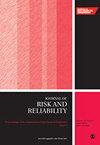基于乘法降维法和泰勒级数展开的高效方差全局敏感性分析方法
IF 1.8
4区 工程技术
Q3 ENGINEERING, INDUSTRIAL
Proceedings of the Institution of Mechanical Engineers Part O-Journal of Risk and Reliability
Pub Date : 2024-04-03
DOI:10.1177/1748006x241240815
引用次数: 0
摘要
本研究基于乘法降维方法,详细推导了计算两个基于方差的全局敏感度指数的无条件统计矩和条件统计矩。此外,还提出了一种利用泰勒级数展开计算性能函数统计矩的有效方法,将其转化为随机变量统计矩的计算。此外,还推导出了正态分布随机变量原始矩的递推公式,并提供了非正态分布随机变量原始矩的计算公式。最后,通过将乘法降维方法与泰勒级数展开相结合,提出了两种更有效的基于方差的全局敏感性指数方法。与参考方法相比,两种方法的效率分别提高了 66.66% 和 33.33%。结合有限元软件,通过低维屋顶桁架和高维十杆桁架结构验证了该方法的准确性和高效性。此外,通过将其应用于包含 28 个输入变量的高维复杂液压管道系统,证明了其工程应用价值。本文章由计算机程序翻译,如有差异,请以英文原文为准。
An efficient variance-based global sensitivity analysis method based on multiplicative dimensional reduction method and Taylor series expansion
In this study, the detailed derivation of unconditional and conditional statistical moments for calculating two variance-based global sensitivity indices is presented based on the multiplicative dimensional reduction method. Furthermore, an efficient calculation method for the statistical moment of performance function is proposed using Taylor series expansion, transforming it into a calculation of the statistical moment of random variable. Additionally, a recursive formula for the raw moment of normally distributed random variables is derived and a calculation formula for non-normally distributed random variables’ raw moment is provided. Finally, by combining the multiplicative dimensional reduction method with Taylor series expansion, two more effective methods are proposed for variance-based global sensitivity index. Compared with the reference method, the two proposed methods increase efficiency by 66.66% and 33.33%, respectively. The accuracy and efficiency of this approach are verified by a low-dimensional roof truss and a high-dimensional ten-bar truss structure in conjunction with finite element software. Moreover, its engineering application value is demonstrated by applying it to a high-dimensional complex hydraulic piping system containing 28 input variables.
求助全文
通过发布文献求助,成功后即可免费获取论文全文。
去求助
来源期刊

Proceedings of the Institution of Mechanical Engineers Part O-Journal of Risk and Reliability
ENGINEERING, MULTIDISCIPLINARY-ENGINEERING, INDUSTRIAL
CiteScore
4.50
自引率
19.00%
发文量
81
审稿时长
6-12 weeks
期刊介绍:
The Journal of Risk and Reliability is for researchers and practitioners who are involved in the field of risk analysis and reliability engineering. The remit of the Journal covers concepts, theories, principles, approaches, methods and models for the proper understanding, assessment, characterisation and management of the risk and reliability of engineering systems. The journal welcomes papers which are based on mathematical and probabilistic analysis, simulation and/or optimisation, as well as works highlighting conceptual and managerial issues. Papers that provide perspectives on current practices and methods, and how to improve these, are also welcome
 求助内容:
求助内容: 应助结果提醒方式:
应助结果提醒方式:


